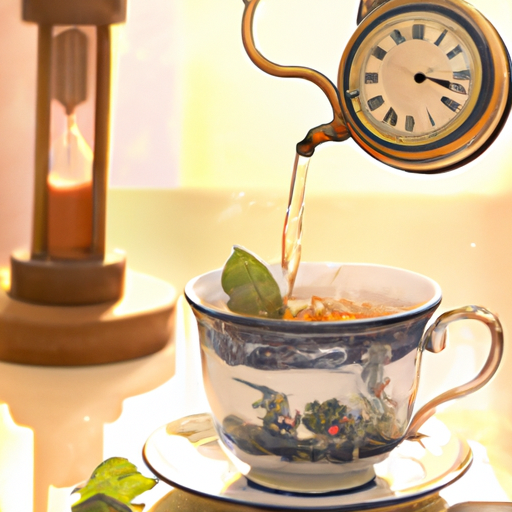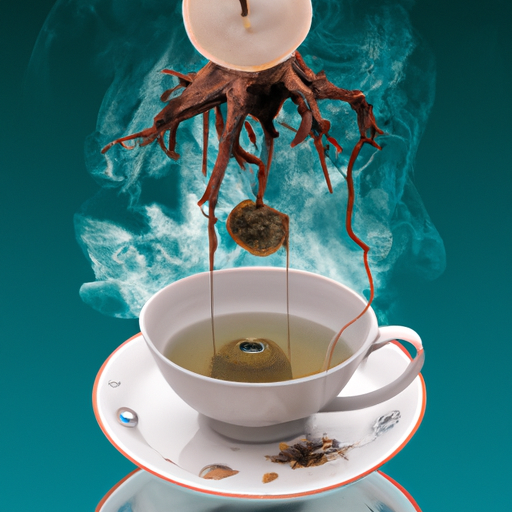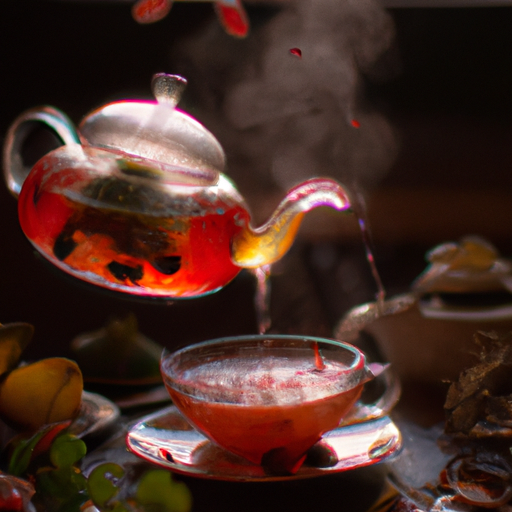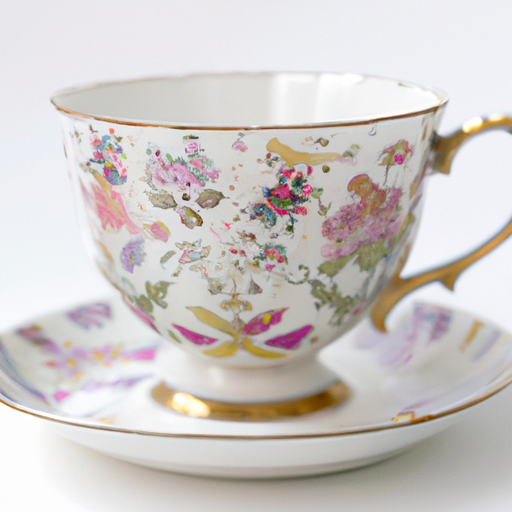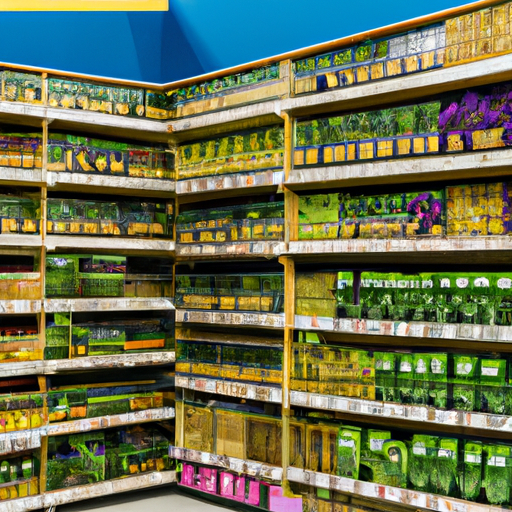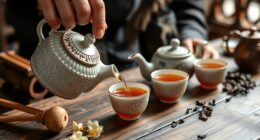So you’re looking to create the ideal cup of tea, huh? Be prepared to delve into a world of flavor and sophistication. Forget about those mundane tea bags – we’re focusing on loose leaf tea here. This is where the true enchantment takes place.
Now, I know what you’re thinking. Isn’t loose leaf tea just a fancy way of saying ‘more work’? Well, my friend, let me assure you that the extra effort is well worth it. You see, loose leaf tea is all about flavor. None of that leftover dust and fannings you find in those sad little tea bags. No, with loose leaf tea, you get the full experience – the larger leaf size means more flavor and aroma in every sip.
But fear not, my fellow tea enthusiasts, for I am here to guide you through the intricate process of making a perfect cup of tea with loose leaf tea. From selecting the right tools to mastering the art of steeping, I will share with you all the secrets to brewing a cup that will transport you to tea heaven.
So, grab your kettle, infuser, and timer, and let’s dive into the wonderful world of loose leaf tea. Trust me, once you taste the difference, you’ll never go back to those mundane tea bags again.
Key Takeaways
- Loose leaf tea offers more flavor than tea bags due to larger leaf size.
- Follow water temperatures for each tea to avoid burning or under-infusing.
- Use tea infuser basket for loose leaf tea to allow leaves to fully expand and release flavor.
- Steeping time and water temperature vary for different types of tea.
Steps to Brew Loose Leaf Tea
I’ll start by gathering the necessary tools for brewing loose leaf tea, such as a kettle, mug or teapot, infuser with a lid, a tea spoon, and a timer.
To ensure a perfect cup of tea, it’s important to follow proper steeping techniques. One option is to use a tea infuser basket, which allows the leaves to fully expand and release their flavor. Another option is a teapot with a built-in strainer.
Once the tools are ready, it’s time to start the brewing process. Heat fresh, filtered water to the specific temperature recommended for the type of tea you’re using. Add hot water to the mug or teapot, then discard it once the container is warm.
Place the tea infuser inside and add one teaspoon of tea leaves for every 8 ounces of water. Cover the mug or teapot to maintain the water temperature and prevent essential oils from escaping.
Set the timer according to the recommended steeping time, and once the time is up, remove the tea leaves. If desired, add milk or sweetener, or enjoy the tea plain.
Remember, high-quality loose leaf teas can often be steeped again for additional cups.
Water Temperature and Timing
To achieve the ideal flavor profile, it’s important to accurately control the water temperature and timing when brewing with loose leaf tea.
Here are some steeping techniques to help you achieve the perfect cup of tea:
-
Different types of tea require different water temperatures. Green tea should be steeped at 175°F, while black tea is best brewed at 212°F. Follow the recommended temperature for each tea to avoid under-infusing or burning the leaves.
-
Timing is crucial for achieving the desired flavor. Steep green tea for 2-3 minutes, black tea for 3-5 minutes, and herbal tea for 5-7 minutes. Adjust the steeping time based on your personal preference for stronger or milder flavors.
-
Over-steeping can result in a bitter taste, so be mindful of the recommended steeping time. If you accidentally over-steeped your tea, adding hot water can dilute the flavor.
-
Experiment with different steeping times to explore the variety of flavor profiles that each tea has to offer. From delicate and floral to bold and robust, the possibilities are endless. Enjoy the journey of discovering the perfect cup of tea.
Tips for Enjoying Your Tea
When I sit down to savor a cup of tea, I like to take my time and appreciate the flavors and aromas. It’s important to choose the right tea for your taste preferences, as different teas offer unique flavors and health benefits. Loose leaf tea, with its larger leaf size, provides a more flavorful experience compared to tea bags. Additionally, loose leaf tea offers numerous health benefits, such as antioxidants and potential weight management properties. To help you choose the perfect tea, I’ve created a helpful table below:
| Tea Type | Flavor Profile | Health Benefits |
|---|---|---|
| Green | Refreshing, | Antioxidants, |
| vegetal | metabolism | |
| ———- | —————- | —————– |
| Black | Bold, robust | Heart health, |
| mental alertness | ||
| ———- | —————- | —————– |
| Herbal | Fragrant, | Relaxation, |
| soothing | digestive aid | |
| ———- | —————- | —————– |
| Oolong | Floral, | Weight |
| fruity | management, | |
| mental clarity | ||
| ———- | —————- | —————– |
| White | Delicate, | Skin health, |
| subtle | immune support |
By understanding the different flavors and health benefits of each type of tea, you can choose the perfect loose leaf tea to enhance your tea-drinking experience.
Frequently Asked Questions
How do I choose the right type of loose leaf tea?
When choosing loose leaf tea, consider your flavor preferences and the health benefits you’re seeking. There are various options available, such as black, green, herbal, and oolong teas, each offering unique flavors and potential health advantages.
Can I use tap water instead of filtered water?
Using tap water instead of filtered water can affect the taste of tea. Tap water may contain impurities or minerals that can alter the flavor. Using filtered water helps ensure a cleaner and more pure taste in your cup of tea.
Should I rinse the tea leaves before steeping?
Rinsing tea leaves before steeping can have both pros and cons. While it can remove any dust or debris, it may also wash away some of the tea’s flavor and aroma. Ultimately, whether to rinse or not depends on personal preference.
Can I reuse the tea leaves for multiple cups of tea?
Yes, you can reuse tea leaves for multiple cups of tea. Reusing tea leaves not only saves money and reduces waste but also allows you to extract additional flavor and health benefits from the leaves.
How can I store loose leaf tea to maintain its freshness?
To store loose leaf tea properly, use airtight containers made of glass, ceramic, or metal. Keep it away from light, heat, moisture, and strong odors. Avoid plastic containers as they can absorb flavors.

